
(Colorado Chess Informant – April 2004)
Oscars for Chess on the Big Screen
By NM Todd Bardwick
Chess has a rich movie tradition through the last century in part due to famous Hollywood types and strong players as Stanley Kubrick and Humphrey Bogart (both expert strength players). Ever since Casablanca, chess has found a part in major motion pictures. The March 1988 Chess Life has a wonderful article written about the chess exploits of Hollywood legends including such greats as Katherine Hepburn, John Wayne, and William Wisdom. The cover of the June 1987 Chess Life features a photo from a chess scene from an episode of the Cosby Show. An article about chess and the hit TV show is featured in that issue.
Usually chess is referenced to show the cleverness of one of the characters. Rarely do we see the actual chess position on the screen.
When Hollywood does show us a position, the average chess player can’t help but notice all the flaws. Usually, for dramatic effect, the players take turns putting each other in check (without escaping check themselves!), until one actor announces “checkmate.” Chess consultants have been hired at times, but even then, movie producers don’t always bother to take the time to listen to them!
Here are the Top 6 Chess Oscars!
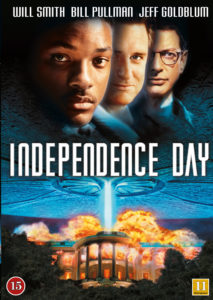
Oscar for the “Last checkmate on Earth, before it was conquered by aliens”
INDEPENDENCE DAY, 1996
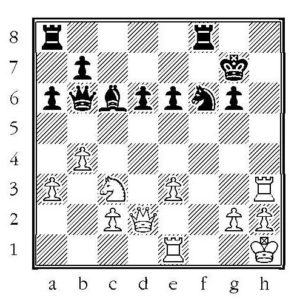
Jeff Goldblum is playing white and Judd Hirsch is black. This is the starting position from their game in the park in New York at the beginning of the movie Independence Day as the characters are introduced. The chess theme is nicely intertwined throughout the plot of the movie as the humans eventually “checkmate” the evil aliens. Notice that black is a piece to a pawn ahead with an easily won game, if he doesn’t walk into a mating net.
Goldblum played 1.e4 followed by 1…e5 by Hirsch. During the dialog between the father and son, Hirsch is impatient that his son is taking too much time for his move. White then plays 2.Qh6+ and in the movie Goldblum doesn’t say check. Of course it is not required to say check in a tournament game, but usually Hollywood overdoes saying check in movies for dramatic effect. Hirsch quickly plays the blunder, 2…Kg8?? (2…Kf7 should be winning for black) and Goldblum, after much thought, plays 3.Qg6 mate.
Nicest touch: Continual references to the chess theme throughout the movie.
Worst blunder: Hirsch makes a fairly obvious blunder. However, on the plus side, the position does work though from a chess perspective.
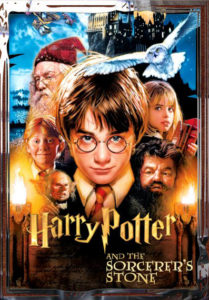
Oscar for “Most violent piece captures”
HARRY POTTER AND THE SORCERER’S STONE, 2001
The wizard’s chess scene from Harry Potter and the Sorcerer’s Stone, where giant stone chess pieces crush each other into rubble as they capture, has created more chess interest among children than any movie since Searching for Bobby Fischer.
The movie plot has the three children (Harry, Hermione, and Ron) chasing after the bad guy as they enter a room of giant stone chess pieces. As they walk across the board, the white pawns stand up, cross their swords, and block the path.
The children must win a chess game to continue their quest.
Several black pieces are missing at the start of the game. Hermione takes the place of the black rook on a8, Harry becomes the dark-squared bishop on f8, and Ron, the best chess player of the three, saddles up on the g8 knight, where he commands the black pieces.
The game opens with the first few moves of the Center Counter Game. 1.e4 d5 2.exd5. The white pawn destroys the black pawn and crushes it, in the spirit of wizard’s chess, to rubble.
A middlegame battle scene ensues with pieces smashing each other to bits as the pieces take turns capturing each other. Curiously, during the battle, two horses (knights, of course) are crushed. Note that at the start of the game, there are four knights on the board. There are also four knights in the diagrammed position below. But two were captured! This was probably an oversight by the producer, but can be explained by the highly unlikely event of two (!) pawn under promotions to knights.
International Master Jeremy Silman cleverly composed this chess scene to be accurate from a chess perspective and to fit the movie plot.
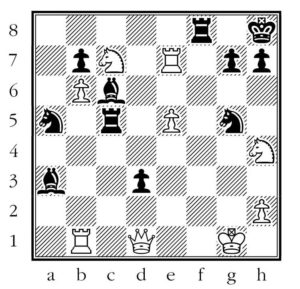
Here is the unedited middlegame chess position designed for the movie with white to move. This position is one move before the diagrammed position shown at the start of this article.
Harry Potter is the black bishop on a3, Hermione is the black rook on f8, and Ron is riding the black knight on g5. The object of the game is to checkmate the white king AND to prevent Harry from getting captured (or else the next movie in the series would be called “Hermione Granger” or “Ron Weasley”)!
Silman composed this position where white would play 1.Qxd3 and, in the spirit of wizards chess, smash the black pawn to bits. This move also defends against the 1…Nh3 mate threat and threatens to capture Harry.
Black would then respond with the brilliant 1…Rc3!, attacking the queen, shielding Harry from attack, and threatening 2…Bc5+ leading to mate.
The actual climatic movie position begins here as white plays 2.Qxc3, destroying the black rook.
The white queen is an overworked piece, and must guard both c5 and h3 against mate threats. Ron nobly sacrifices himself by playing 2…Nh3+. Note that Harry could force mate in two, but would be captured in the variation 2…Bc5+, 3.Qxc5 Nh3 mate.
White plays 3.Qxh3 as the queen stabs Ron’s horse and knocks Ron to the ground.
The “touch move” rule is cleverly incorporated into to the scene as Hermione starts to move off f8 to help Ron. Harry yells to her not to move off her square because the game is still in progress. She obeys and centers herself on f8.
Harry moves 3…Bc5 and, in the movie, announces mate. The king drops his sword and Harry and Hermione go to help Ron. Actually, this is not checkmate, as white can interpose the queen by playing 4.Qe3. Silman intended that black would respond 4…Bxe3 mate allowing Harry to take revenge on the powerful white queen who captured Ron, the rook, and the pawn. The movie editors probably didn’t check out this final “checkmate” position with Silman, before cutting down the scene. Oops! (A nice article on this chess position can be found in the September 2002 edition of MUSE magazine.)
Nicest touch: Jeremy Silman did a masterful job of designing a position that works nicely from a chess perspective and the movie plot.
Worst blunder: It is too bad that they edited out the nice move, 1…Rc3!
Announcing checkmate, when it wasn’t checkmate is tragic!!
Moral of the story: If you go through the trouble of hiring a chess consultant (a smart move), at least consult him before initiating changes in the position!
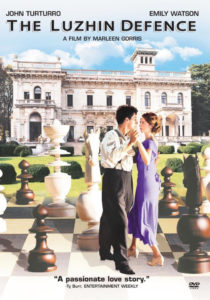
Oscar for “Best Romantic Chess Movie”
THE LUZHIN DEFENCE, 2000
The Luzhin Defence, released in 2000 and based on the book, The Defense, by Vladimir Nabokov, combines every chess player’s passions…chess and love.
John Turturro portrays Alexander Luzhin, an eccentric genius Russian chess master whose unstable childhood has made him incapable of relating to others. Chess is Luzhin’s only escape until he meets and falls in love with the caring Natalia at an Italian resort where he is the favorite in a prestigious chess championship.
This story of love and obsession features simultaneous chess exhibitions, a blindfold exhibition, and a fabulous giant chess set on the lawn of the resort.
The final game between Luzhin and Turati, his archenemy, and is brilliantly played and realistic from a chess perspective thanks to British grandmaster Jon Speelman, the movie’s chess consultant.
Both players are in time pressure and neither is keeping score as they reach time control at move 40. Luzhin’s flag falls. The tournament director notes that they passed move 40 and asks Luzhin to seal a move. The game is adjourned.
During the adjournment, Luzhin has a nervous breakdown and after promising that he will give up chess and marry Natalia, he is overcome by the pressures of his life and jumps out a window to his death, his final defence. Nabokov may have taken a page from the death Kurt Von Bardeleben (from the famous Hastings 1895 game against Steinitz) who jumped from a window to his death in 1924.
While Natalia is grieving and packing his clothes, she finds a note in his pocket with the winning variation from the adjourned position. Turati agrees to let her finish the game, using Luzhin’s notes.
Luzhin
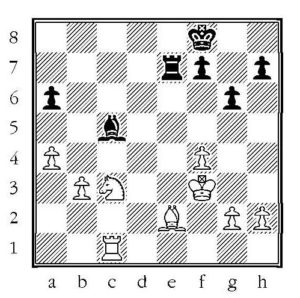
Turati
The game continued, 43…Re3+ 44.Kg4 (44.Kf2 loses to 44…Rxc3+) f5+ 45.Kg5 (45.Kh4 Be7 mate) 45…Kg7 (threatening 46…Be7 mate) 46.Nd5 Rh3! (a brilliant rook sacrifice threatening 47…h6 mate) 47.gxh3 h6+ 48.Kh4 Bf2 mate
Nicest touch: The final position with the rook sacrifice is nicely done. Luzhin is totally engulfed by “the chess bug” that many tournament players experience from time to time. In the time scramble before the adjournment, they do a nice job moving the pieces in fast motion to show his analysis and thoughts.
Worst blunder: In the credits, they said the chess consultant was John Speelman, not Jon Speelman!
Moral of the story: Listen to your chess consultant and all is well with the world.

Oscar for “Best portrayal of chess bums gambling in a park”
SEARCHING FOR BOBBY FISCHER, 1994
True story by Fred Waitzkin, whose son Josh, captured the 1986 National Elementary School Championship at age 8. Is he the next Bobby Fischer? Josh is a normal kid who discovers his talent for chess watching players in New York’s Washington Square Park.
Note that the movie varies quite a bit from the book.
The movie has nice footage of Bobby Fischer and some real life grandmasters. Bruce Pandolfini, Josh Waitzkin’s real life coach, also made a cameo appearance in the movie and says, “Young Fischer”, to Ben Kingsley (who plays Pandolfini in the movie) as Josh is playing in the park.
In the critical last round, Josh offers a draw after he sees a win, but his opponent rejects it and goes on to lose the game.
In real life, Josh’s opponent was Jeff Sarwer, another chess prodigy who went on to win the under-10 World Junior Championship before emotional problems crippled his chess game. Waitzkin and Sarwer drew in the actual game in real life.
In the climatic game position composed for the movie, Josh’s coach (Kingsley) tells his parents that he has a chance to win. As Josh thinks, Kingsley talks through the winning line, which he says is twelve moves away.
The designed position is good (especially the skewer at the end), but the line isn’t forced and there are three theoretical draw opportunities for white.

The movie continued, 1…gxf6 2.Bxf6 Rc6+ 3.Kf5 Rxf6+ (3…Bxf6 4.Ra5 Bxh4 5.Rxa7 is a theoretical draw with R+N+B vs. R+N) 4.Nxf6 Bxf6 5.Kxf6 (5.Ra5 Bxh4 6.Rxa7 or the better 5.Rc5+ Kd3 6.h5 are drawing) 5…Nd7+ 6.Kf5 Nxe5 7.Kxe5? (White misses his last chance to draw. 7.h5! Nf7 (or 7…a5 8.h6 a4 9.h7 a3 10.h8=Q a2 11.Qxe5 Kb1 draws because a rook pawn on the 7th vs. a queen is a draw with the white king too far away to help) 8.Kg6 Ne5+ 9.Kf5 Nf7 is a draw as the annoying knight prevents white’s pawn from advancing.) 7…a5 8.h5 a4 9.h6 a3 10.h7 a2 11.h8=Q+ a1=Q+ 12.Kf5 Qxh8 13.Resigns
Nicest touch: I liked the actual footage of Bobby Fischer that was interspersed into the movie. The subplot battle between Laurence Fishburne and Ben Kingsley about taking the queen out early was well done and well as the occasional real life portrayal of some parents who become obsessed with their children’s chess achievements.
The blindfold chess-bathtub scene, at the beginning of the movie and the locking up the parents during the tournament games so they wouldn’t interfere with the games were cute.
The movie also accurately portrayed many top-level chess players, who are brilliant at chess, but social misfits and often bums (the crazed player in the scene at the chess club and the hustlers in the park).
Although there are some drawing lines for white during the movies’ climax in the final chess game, the scene is well done, especially as Ben Kingsley talks through the final line as Josh thinks in the tournament room.
Worst blunder: Too many chess errors were made during the chess scenes. Did they ask Pandolfini for his input or did they just ignore his suggestions?
In the movie’s tournament games, the children don’t keep score, slam the clocks (Hollywood can’t resist this!), and where are the tournament directors during the final game?? Also, while I am nitpicking rampage, note that the first time control set on the chess clock is at 12:00, not the standard 6:00.
During the final game, Josh sticks out his hand to offer a draw, without making his move first (the proper procedure). This is another Hollywood failed attempt at dramatic effect. Of course in real life, a player offers a draw verbally, not by blocking his opponent’s view of the board with his hand. Unfortunately, many kids who have seen the movie picked up this bad habit and stick their hand out to offer a draw.
In one of the opening scenes as they introduce the Laurence Fishburne character in the park, he is trying to hustle a grandmaster, played by Kamran Shirazi. Most chess players know that Shirazi is an IM, not a GM.
Another error on the chessboard occurs just before Josh loses his queen in the early middlegame during the final game. Kingsley and Fishburne are arguing about bring the queen out early. Josh plays …Qa5+ and his opponent responds with Bd2. If you look closely, in one scene white has a bishop on f1, the next move it is a rook…a few moves later is a bishop again! After Bd2, Josh retreats his queen…to e7! (illegal). After Rf2 (the bishop on d2 magically ends up back on g5), Josh moves his pinned (!) knight on f6 to take the e4 pawn and white plays Bxe7 (Q). Ironically, Josh didn’t lose his queen because it came out early, but because he moved a pinned knight. Having the game follow the opening book moves of, say, a Poisoned Pawn Sicilian would be both simple and realistic.
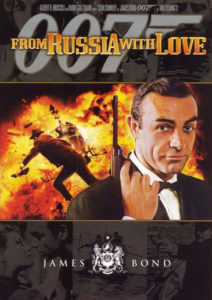
Oscar for “Most beautiful setting for a chess game in a spy movie”
FROM RUSSIA WITH LOVE, 1963
The 1963 James Bond movie, “From Russia with Love,” may be the most famous movie of all time that incorporates chess.
The movie opens with S.P.E.C.T.R.E. agent Grandmaster Kronsteen (Czechoslovakia), Bond’s archenemy, brilliantly defeating a Canadian grandmaster Macadams in what they call the Venice Invitational Grandmasters Championship.
The setting is a beautiful old castle with a large demonstration board where the pieces are moved with long sticks (looks like a magnetic type of board). A large audience watches the game in this classic chess setting.
Because of the time when the movie was made, the moves are called out in descriptive notation…I’ll use algebraic notation below.
The intended critical position shown in the movie is from Spassky-Bronstein, 28th USSR Championship, 1960. Here is the game score in algebraic notation.
1.e4 e5 2.f4 exf4 3.Nf3 d5 4.exd5 Bd6 5.Nc3 Ne7 6.d4 0-0 7.Bd3 Nd7 8.0-0 h6 9.Ne4! Nxd5 10.c4 Ne3 11.Bxe3 fxe3 12.c5 Be7 13.Bc2 Re8 14.Qd3 e2 15.Nd6! Nf8 16.Nxf7 exf1=Q+ 17.Rxf1 Bf5 18.Qxf5 Qd7 19.Qf4 Bf6 20.N3e5 Qe7 21.Bb3 Bxe5
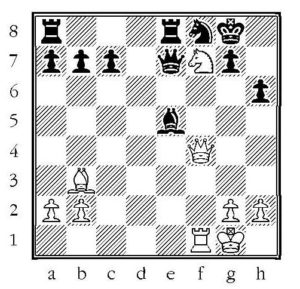
Movie position after 21…Bxe5
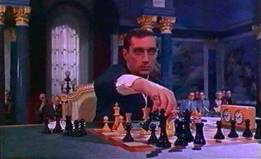 This is the position shown in the movie. If you play out the moves in the actual game above, you will see a huge mistake in the chess position… This is the position shown in the movie. If you play out the moves in the actual game above, you will see a huge mistake in the chess position…
Where are the white pawns on d4 and c5???!! Amazingly, after selecting a great game to base the movie position on, they forgot two critical center pawns!!! Ooops!
Here are the final moves in the movie, which mirror the actual game: 22.Nxe5+ Kh7 (22…Kh8 23.Qg4 threatening both 24.Rf7 and 24.Rxf8+ followed by 25.Ng6+) 23.Qe4+ Resigns
Another curiosity is that Kronsteen says check after playing 22.Nxe5+, but forgets to say check after 23.Qe4+. Of course, this is legal and all, but how about consistency?
Here is a photo of Vladek Sheybal, who portrayed Kronsteen, in From Russia with Love.
Nicest touch: Where else can you see the royal game played in such a royal setting? Introducing the Kronsteen character through chess is well done.
Worst blunder: The missing white center pawns on d4 and c5 make the scene inaccurate from a chess perspective.
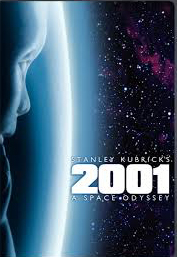
Oscar for “Best chess game ever played on a trip to Jupiter”
2001: A SPACE ODYSSEY, 1968
1968 – Stanley Kubrick, producer
Stanley Kubrick is well known as Hollywood’s strongest chess player. He was probably of strong expert level strength, somewhere in 2100’s. Humphrey Bogart would be a close second, by most accounts a weak expert strength player.
The theme of this movie is the power struggle between man and machine, on a long, top-secret space trip to Jupiter on board the ship, Discovery One. Dave Bowman is the commander of the mission. Frank Poole is his deputy. Three other members of the crew are in hibernation: Jack Kimball, Charles Hunter, and Victor Kominsky. The last member of the crew is the HAL 9000 computer, which controls the ship.
An interesting note is that by adding one letter to each letter in “HAL” and you get IBM. A coincidence?!
Before the mission goes awry, Frank and HAL are engaged in a friendly chess game to show how intelligent HAL is because he can beat a human. Keep in mind that back in 1968, unlike today, computers were extremely poor chess players (if computers even played chess back then?!).
The first chess reference in the movie is introduction of an insignificant character by the name of … Dr. Smyslov! (Vassily Smyslov was World Chess Champion in the late 1950’s.)
The movie chess game between Frank and HAL is based on this real-life game from 1913:
Roesch (Frank) – Schlage (HAL)
Hamburg 1913
1.e4 e5 2.Nf3 Nc6 3.Bb5 a6 4.Ba4 Nf6 5.Qe2 b5 6.Bb3 Be7 7.c3 0-0 8.0-0 d5 9.exd5 Nxd5 10.Nxe5 Nf4 11.Qe4 Nxe5 12.Qxa8 Qd3 13.Bd1 Bh3 14.Qxa6 Bxg2 15.Re1 Qf3! 16.Resigns (16.Bxf3 Nxf3 mate or 16.h4 Nh3+ 17.Kh2 Ng4 mate)
 Position after 13…Bh3 Position after 13…Bh3
Here is the position that opens the chess scene. It is a little difficult to make out the pieces on HAL’s flat computer monitor from the camera distance in the movie. In 1968, of course, descriptive notation was commonly used.
Here is the dialog between Frank and HAL (without the move numbers which I include for clarity).
Frank: “14.QxP”
HAL: “14…BxNP”
Frank: “15.R-K1”
HAL: “I’m sorry Frank, I think you missed it. 15…Q-B3 16.BxQ NxB mate”
Frank: “Looks like you are right. I resign.”
HAL: “Thank you for a very enjoyable game.”
Frank: “Yea, thank you.”
Their are two chess errors in this sequence.
First, is HAL’s 14…BxNP. Of course, this is the only pawn that can be captured by a bishop and the shorter, 14…BxP, would suffice.
Secondly, is Black’s 15…Q-B3. Since it is Black’s move, the move should be stated from his perspective – and be 15…Q-B6. Since it is highly unlikely that Kubrick, an accomplished chess player, would miss this, it has been suggested that perhaps it was intentional and HAL was testing Frank to see if he would notice. You decide!
Nicest touch: Good choice of games. Nice incorporation of chess into the movie plot.
Worst blunder: The camera angle shows the game looking over Frank’s shoulder from a long distance away. You can barely make out the pieces and moves from the camera. They could have zoomed in a little more on the position, for the benefit of the chess players. |